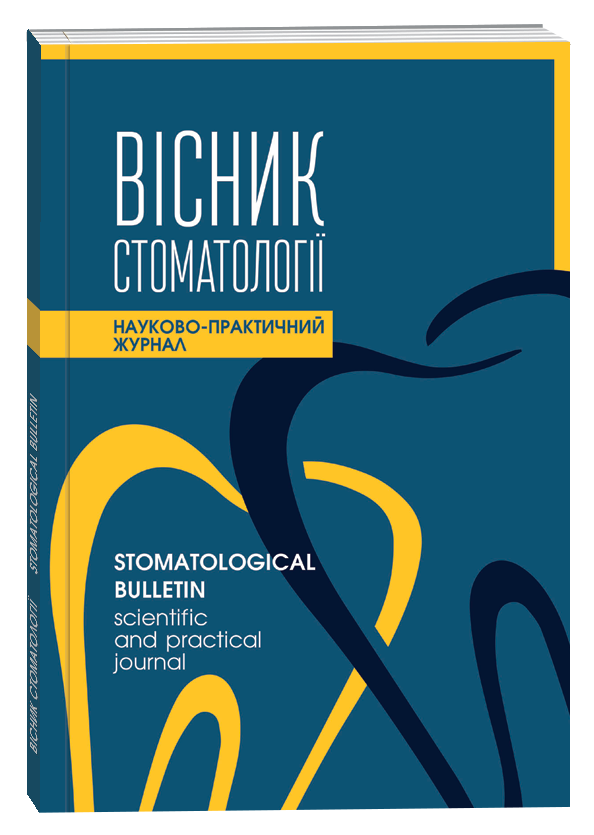USE OF THE COMPUTER SIMULATION METHOD FOR POSITIONING THE IMMOBILIZATION SYSTEM IN CASE OF LUXATION OF TEETH IN CHILDREN
DOI:
https://doi.org/10.35220/2078-8916-2023-49-3.19Keywords:
children, traumatic injuries, maxillofacial region, CAD/CAM, teeth, splint constructionAbstract
Today, computer modeling in combination with experimental methods of studying the stress-strain state (SSS) of biomechanical systems (Bs) are the most informative modern tools not only for planning surgical operations, but also for determining the possibility and method of using fixing devices. The finite element method (FEM) is well adapted to the complex geometry of Maxillofacial tissues. Its first applications in the field of Dentistry were carried out back in 1973. The purpose of the study is to determine the optimal level of placement of the splint structure on the injured teeth of the child's upper jaw, depending on the two variants of the root formation and the presence of contacts between the teeth under the influence of two directions of functional load on the teeth. Materials and methods. The object of the research was 24 three-dimensional computer models of the biomechanical system of the upper jaw with a splinting system for fixing teeth. To achieve the goals, CAD/CAE methods and computer tomography data were used to create models of the stress-strain state of the biomechanical system of the upper jaw with splinting structures of the dental row. Results. Due to analysis of the results obtained, the qualitative characteristics of displacement and stress fields were established. Teeth having 70 % of unformed root are less capable of impact under the pressure of compression and bending. The system exhibits a greater resistance at 2.8 times to the compression of the Рzi than the bend of Pyi. The absence of contact contributes to the mobility of the system at 1.5 times. Conclusions. The pathogenetic factors that influence the rigidity of the splint fixation on the injured teeth have been identified including a degree of root formation, the direction of the force impact, the position of the splint on the crown of the tooth, the presence of contact between adjacent teeth.
References
Маланчук В.О., Крищук М.Г., Копчак А.В. Імітаційне комп’ютерне моделювання в щелепно-лицевій хірургії. Київ: Видавничий дім «Асканія», 2013, 231с.
Яковенко Л.М., В.П. Єфименко, А.Ю. Макаревич, Т.О. Ковтун Травми тимчасових і постійних зубів у дітей (діагностичні заходи, лікувальна тактика). Науковий журнал Медичні перспективи. 2016. № 4. С. 106-115
Єщенко В.О. Імітаційне моделювання напружено-деформованого стану біомеханічних систем для кісток кінцівок та щелепи людини з пошкодженнями.
Вісник Національного технічного університету України «Київський політехнічний інститут». Серія машинобудування. 2013. № 2 (68). С. 84-91.
Леоненко П.В., Єщенко В.О. Скінчено-елементний аналіз імітаційної трьох-вимірної моделі біомеханічної системи «кісткова тканина – дентальни імплантат – супраконструкція». Вісник Національного технічного університету України «Київський політехнічний інститут». 2012. № 65. С. 105-109.
Павленко О.В., Леоненко П.В., Крищук М.Г., Єщенко В.О. Раціональне планування хірургічних та ортопедичних реконструктивних заходів шляхом ство
рення індивідуальних імітаційних моделей біомеханічної системи з дентальними імплантатами. Вісник Української медичної стоматологічної академії. Полтава, 2013. № 21. Т.13. С. 25 – 29.
Бабкина Т.М., Демидава Е.А. Сучасні підходи до діагностики травм щелепно-лицевої ділянки. Вісник стоматології. 2013. № 3. С. 83-90.
Мандзюк Т., Вовк В. Огляд проблем комп'ютерного моделювання біомеханічних систем у стоматології. Вісник Львівського університету. 2008. № 14. C. 105–122
Benzing U. R., Gall H., Weber H. Biomechanical aspects of two different implant-prosthetic concepts for edentulous maxillae. The International journal of oral & maxillofacial implants. 1995. № 10(2). Р. 188–198.
Cervino G. Fiorillo L., Arzukanyan A. V., Spagnuolo G., Campagna P., Cicciù, M. Application of bioengineering devices for stress evaluation in dentistry: the last 10 years FEM parametric analysis of outcomes and current trends. Minerva stomatologica. 2020. № 69(1), 55–62. doiI: 10.23736/S0026-4970.19.04263-8.
Jain A., Prasantha G. S., Mathew S., Sabrish S. Analysis of stress in periodontium associated with orthodontic tooth movement: a three dimensional finite element analysis. Computer methods in biomechanics and biomedical engineering. 2021. № 24(16). 1841–1853. https://doi.org/10.1080/10255842.2021.1925255
Bo Huo еt al. An Homogeneous and Anisotropic Constitutive Model of Human Dentin. J. Biomech. 2005. Vol. 38. P. 587–594.
Katz J. L., Meunier A. The Elastic Anisotropy of Bone and Dentitional Tissues. J Mater Sci Mater Med. 2005. Vol. 16. N 9. P. 803–806.
Neves A.A., Pereira L.C., Duda F.P. Stress Distribution in Bidimensional Finite– element Models Regarding Enamel Anisotropic Properties. 83rd General Session Exhibition of the IADR. 2005. Vol. 1. P. 1–2.
Терапевтична стоматологія дитячого віку. Том 1 / Л.О. Хоменко та ін. Видавництво медичної літератури "Книга плюс", 2014 430 с.
Firrao D. et al. Convegno Nazionale IGF XX, Torino 24-26 giugno 2009. P 25.
Маланчук В. О., Крищук Н. Г., Короткоручко А. А. Особливості відтворення функціональних навантажень в імітаційних моделях кісток середньої зони обличчя. Український медичний часопис. 2011. № 2 (82) III – IV.
Ansys Help “help/ans_elem/Hlp_E_SOLID187.html”
Леоненко П.В., Крищук М.Г., Єщенко В.О. Порівняльний біомеханічний аналіз конструкцій зубних шин в експериментальному моделюванню генералізованого пародонтиту. Ліки України плюс. 2013. № 2 (15). C. 60–64.
João Paulo M. Tribst, Amanda Maria de O. Dal Piva, Erik J. Blom, Cornelis J. Kleverlaan, Albert J. Feilzer. Dental biomechanics of root-analog implants in different bone types. The journal of prosthetic dentistry. https://doi.org/10.1016/j.prosdent.2022.10.005
Ming-Lun Hsu and Chih-Ling Chang. Application of Finite Element Analysis in Dentistry, Finite Element Analysis, David Moratal (Ed.), doi: 10.5772/10007
Ковтун Т.О. Визначення розподілу навантаження в біомеханічній системі «зубний ряд–шина–кістка» у дітей з травмами зубів. Новини стоматології. 2019. № 3 (100). С. 82-87.









